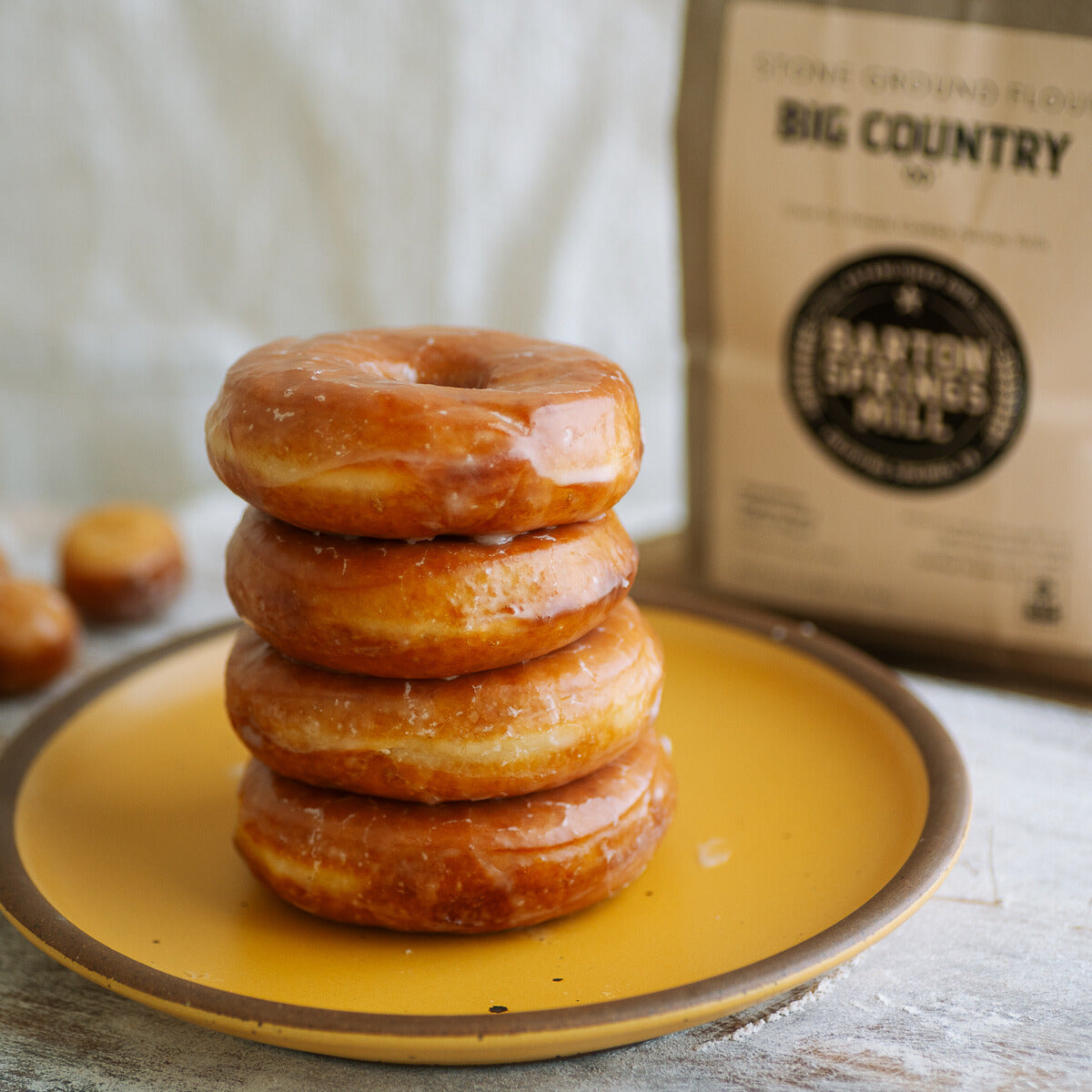Add description, images, menus and links to your mega menu
A column with no settings can be used as a spacer
Link to your collections, sales and even external links
Add up to five columns
Add description, images, menus and links to your mega menu
A column with no settings can be used as a spacer
Link to your collections, sales and even external links
Add up to five columns
Add description, images, menus and links to your mega menu
A column with no settings can be used as a spacer
Link to your collections, sales and even external links
Add up to five columns
Add description, images, menus and links to your mega menu
A column with no settings can be used as a spacer
Link to your collections, sales and even external links
Add up to five columns

Glazed Donut Recipe
May 30, 2023 4 min read
Glazed Donut Recipe
Yield: 15 Donuts and holes
Download a printable version of the recipe here.
**This is an overnight recipe
Tangzhong:
30g BSM Stardust 00 flour
130g whole milk
Dough:
200g whole milk
28g sugar
8g dry active yeast
40g milk powder
7g salt
1 egg + 2 yolks
360g BSM Stardust 00 flour
72g softened unsalted butter
Canola oil for frying
Glaze:
350g confectioner’s sugar
75g hot water
8g vanilla
3g salt
To make the Tangzhong:
In a small saucepan, weigh 130g of whole milk and 30g flour. Whisk out any lumps and
continuously whisk over medium heat until it forms a thick paste. Set aside.
Dough method:
In a standup mixer, add the Tangzhong, 200g cold milk, and sugar. Whisk to dissolve and to allow
the hot Tangzhong to cool from the cold milk. Add in the yeast and whisk to dissolve. Let stand
for 15 min to allow the yeast to bloom. Add the eggs to the liquid mixture.
Measure both flours, milk powder, and salt in a separate bowl. Add dry ingredients to the yeasted liquid and switch to the dough hook for 15 min on medium-high speed. Scrape the sides of the bowl to ensure all of the dry ingredients are incorporated. The dough will be sticky.
Allow to rest for 10 min.
Add the butter half at a time while using the dough hook on medium speed. Once all the butter is added, continue on medium-high speed for 5 min. Do a windowpane test.
Turn dough out onto a floured work surface and knead by hand for 2 min until an elastic dough ball is formed. Add a little flour to your work surface if needed while kneading to prevent
sticking. This is meant to be a sticky dough, so don’t fret!
Use a clear plastic container or bowl that is more than twice the size of the dough ball.
Spray the container with pan spray to prevent sticking. Place the dough ball in the container seam side down and cover with plastic food wrap. The dough should double in size in the refrigerator
overnight (8 hours or so), as this allows the dough a long cold bulk fermentation for the flour to fully hydrate.
(**Note: This can be made the same day using a 2-2 1⁄2 hour bulk ferment at room temperature or when doubled in size. For best results, a longer cold fermentation is recommended. A 75F room temp is best for the dough to rise properly. Remember, temperature
is an ingredient in bread making!)
Remove dough from fridge and let stand for 15 min. On a lightly floured work surface, roll the dough out until it is 3⁄4 in thick. Dust the surface and the rolling pin with more flour if needed.
Using a donut cutter or round biscuit cutter, cut out the donut rounds, followed by using a smaller cutter for the holes. Take the scrap dough and gently bring back together into one mass.
Allow to rest for 5min before re-rolling out to 3⁄4 in thickness. Cut out the remaining donuts to yield about 15 in total.
Cut out 15 individual 6 in square pieces of parchment paper. Spray each piece lightly with pan spray and place a donut on each individual square. Allow your donuts to proof all together on a
baking sheet for about 1 1⁄2 hours or until you do a finger test. If you press your finger into the dough and it holds an indention, it is ready. Place the holes on a separate lightly sprayed piece of parchment.
**Pro Tip: The parchment squares will allow you to gently reverse the donuts into the oil without touching and deflating the donut with your hands. You will thank me later!
**If your kitchen tends to be cool, place your tray of donuts in your non-heated oven on the top rack with a tray on the bottom rack filled with boiling water. This will create a proofing environment. If you have a proofer setting on your oven, turn this setting on before placing the
tray in the oven for a total of 1 1⁄2 hours to final proof.
When your donuts are ready to fry, heat a stock pot with about 4 inches of canola oil. Using a fry thermometer attached to the pot, heat until the temperature reaches 340F. Be sure to maintain the oil at 340F.
Lift a donut on its parchment square and reverse it gently into the hot fry oil. You should be able to fit 3 in at a time. Fry each side for about 1 min or until each side turns a light golden color. If they seem too dark, the oil may be too hot. Ensure the oil stays around 340F by adjusting the heat setting periodically. Using a slotted spoon or spider, remove the donuts from the oil and place onto a cooling rack over a tray. If you line the tray with parchment, this will make for
easier cleanup later.
Allow the donuts to cool slightly for about 2 min before glazing.
For the glaze:
Mix the glaze while you wait for the oil to come up to temp. Add the confectioner’s sugar to a large mixing bowl. Pour the hot water into the bowl, followed by the vanilla extract. Whisk until
you no longer see lumps. Add the salt and whisk together.
Dip the donuts into the glaze when they are warm but not hot, submerging on both sides. Allow the donut to drip excess glaze before placing back on the cooling rack. Allow the donuts to cool
until the glaze has set.
Will keep for a day at best at room temperature in an airtight container.
Enjoy as soon as you can with a cup of hot coffee! You will be glad you spent all this time making these super soft homemade glazed donuts with real ingredients free from added preservatives.
